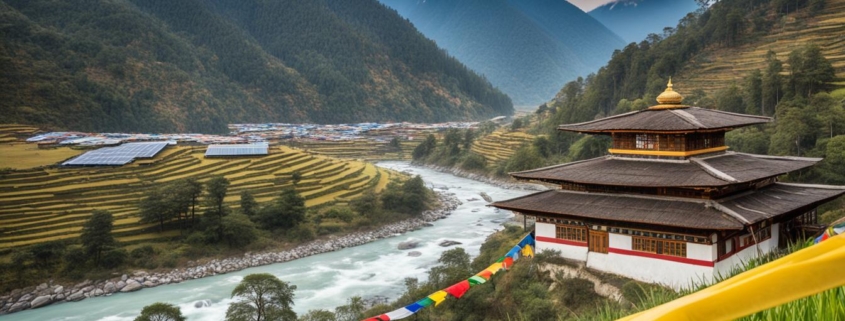Eco-Friendly Travel Destinations for Solo Travelers
As an environmentally conscious solo traveler, it’s important to consider the impact of our trips on the world. While achieving complete carbon neutrality may be challenging, there are destinations that prioritize sustainability and offer eco-friendly travel experiences. In this article, we will explore seven such destinations that are perfect for solo adventurers who want to embrace sustainability on their journeys of self-discovery.
Bhutan – The Carbon-Negative Wonder
Bhutan is an incredible destination that stands out for its commitment to sustainability. It is the world’s only carbon-negative country, meaning that it absorbs more carbon dioxide than it produces.
To preserve its pristine environment, Bhutan has implemented a tourist tax, requiring visitors to pay a daily fee that goes towards education, healthcare, poverty alleviation, and infrastructure development.
With 60% of its land protected as forest, Bhutan offers solo travelers a unique opportunity to experience the beauty of nature while supporting sustainable tourism initiatives.
Experience the awe-inspiring landscapes of Bhutan, where the harmony between nature and culture is deeply ingrained in everyday life. From the majestic Himalayas to sacred monasteries, every corner of this carbon-negative wonder offers a glimpse into a serene and sustainable way of living.
The Galapagos Islands – A Haven for Nature Lovers
The Galapagos Islands, a UNESCO World Heritage Site, is a paradise for eco-conscious travelers. The islands have implemented strict regulations to protect their fragile ecosystems, including a transit control card and an entry tax to contribute to conservation efforts. With limited flights and responsible tourism practices in place, solo adventurers can explore this diverse archipelago while minimizing their ecological footprint. From diving to hiking, the Galapagos Islands offer unique opportunities to connect with nature and witness incredible wildlife.
“The Galapagos Islands are a true marvel of nature. With their rich biodiversity and stunning landscapes, they provide an unforgettable experience for eco-conscious travelers.” – Jane Smith, Wildlife Conservationist
Visiting the Galapagos Islands is not just a chance to enjoy a breathtaking vacation; it is also an opportunity to contribute to wildlife conservation and environmental preservation. The Archipelago straddles the equator in the Pacific Ocean, approximately 620 miles off the coast of Ecuador, making it a remote and pristine destination.
The Galapagos Islands are known for their unique and diverse wildlife, including giant tortoises, marine iguanas, and blue-footed boobies. These extraordinary creatures have captivated scientists, researchers, and visitors for centuries with their adaptations and behaviors that have evolved in isolation from the mainland.
When planning a trip to the Galapagos Islands, it is important to book through licensed tour operators who abide by the guidelines set by the Galapagos National Park and the Galapagos Marine Reserve. These guidelines ensure that visitors have minimal impact on the delicate ecosystem of the islands.
Conservation Efforts
The Galapagos Islands have long been a focal point for wildlife conservation efforts. In recent years, various initiatives have been put in place to protect the islands and their unique inhabitants. Some of these initiatives include:
- Strict visitor limits to minimize disturbance to wildlife.
- Regulated diving and snorkeling activities to prevent damage to the underwater ecosystem.
- Controlled access to sensitive areas to prevent habitat destruction.
- Monitoring programs to track and study the populations of endangered species.
By visiting the Galapagos Islands, solo travelers can support these conservation efforts and contribute to the preservation of this natural wonder.
Experiencing the Galapagos Islands
Exploring the Galapagos Islands offers a truly immersive experience in nature. Whether you choose to embark on a guided cruise or stay on one of the inhabited islands, there are plenty of activities to engage in:
- Snorkeling and diving to discover the diverse marine life, including sea turtles, penguins, and colorful tropical fish.
- Hiking along volcanic trails to witness the unique landscapes and spot endemic species.
- Observing the fascinating courtship rituals of the famous blue-footed boobies.
- Visiting the Charles Darwin Research Station to learn about ongoing conservation efforts and the islands’ scientific importance.
The Galapagos Islands offer a blend of adventure, education, and relaxation for solo travelers who are passionate about wildlife conservation. With their breathtaking beauty and commitment to sustainability, these islands are a haven for nature lovers.
Iceland – Sustainable Wonders in the Land of Fire and Ice
Iceland, known as the Land of Fire and Ice, has emerged as a top destination for solo travelers seeking sustainable adventures. However, the country faces the challenge of overtourism due to its small population and a surge in visitor numbers. Despite this, Iceland has been proactive in promoting sustainable travel practices to preserve its unique natural beauty.
One of the key ways Iceland prioritizes sustainability is by harnessing its abundant geothermal energy sources, which power a significant portion of the country’s electricity and heating systems. This renewable energy not only reduces carbon emissions but also serves as a shining example of sustainable energy practices for the world.
Preserving Pristine Landscapes
Iceland’s commitment to sustainable travel extends beyond energy sources. The country has implemented measures to educate visitors about responsible tourism and minimize waste. One such initiative is the “Leave No Trace” campaign, which encourages travelers to respect the fragile ecosystems and leave them as they found them.
In addition, eco-friendly transportation options, such as electric buses and hydrogen-powered cars, are available for solo travelers to explore Iceland’s scenic wonders without leaving a significant carbon footprint.
“Iceland’s breathtaking landscapes serve as a reminder of the importance of sustainable travel and the need to protect our planet for future generations.” – Traveler
Supporting Local Communities
When solo travelers choose to visit Iceland, they have the opportunity to contribute directly to local communities and support sustainable tourism initiatives. Staying in locally-owned accommodations, dining at farm-to-table restaurants, and participating in community-led initiatives not only promotes economic growth but also helps preserve Icelandic traditions and cultures.
Embracing Responsible Adventure
Solo travelers in Iceland can immerse themselves in a wide range of sustainable adventures. From hiking through pristine national parks to witnessing breathtaking waterfalls and exploring spectacular ice caves, each experience offers a chance to connect with Iceland’s unique natural wonders while leaving a positive impact.
| Sustainable Travel Experiences in Iceland | Description |
|---|---|
| Hiking in Thorsmork | Traverse through Iceland’s stunning highlands, experience diverse landscapes, and witness the unique flora and fauna. |
| Snorkeling in Silfra | Explore the crystal-clear waters of Silfra fissure, located within Thingvellir National Park, and witness the breathtaking underwater world between the Eurasian and North American tectonic plates. |
| Glacier Walking | Embark on an unforgettable journey across majestic glaciers, guided by experienced professionals who prioritize safety and environmental conservation. |
By embracing sustainable practices and supporting local communities, solo travelers can make a positive impact while exploring the wonders of Iceland’s exceptional landscapes.
Kenya – Leading the Way in Sustainable Tourism
Kenya is a trailblazer in sustainable travel and wildlife conservation. The country has made significant strides in promoting renewable resources and protecting its diverse ecosystems. One noteworthy step is the ban on plastic bags and single-use plastics, demonstrating Kenya’s strong commitment to environmental conservation.
Solo travelers have the opportunity to directly contribute to wildlife preservation and support local communities by staying at conservancies owned by the very people who are invested in conservation efforts. By choosing to stay in these conservancies, solo adventurers not only get to experience the beauty of Kenya’s wildlife up close but also contribute to the local economy and sustainable tourism practices.
With its breathtaking landscapes and rich biodiversity, Kenya offers solo travelers an unforgettable and sustainable travel experience. The country boasts 55 national parks, each with its own unique charms and opportunities for encounters with majestic wildlife. Whether it’s witnessing the Great Migration in Maasai Mara, embarking on a safari in Amboseli National Park, or exploring the remarkable biodiversity of Tsavo National Park, Kenya is a haven for those seeking to connect with nature and support wildlife conservation.
Through its dedication to sustainable travel and wildlife conservation, Kenya serves as an inspiring example to other nations around the world. By choosing to explore this remarkable country, solo travelers can have a positive impact and be part of Kenya’s ongoing efforts to protect its natural heritage for generations to come.
FAQ
What is eco-friendly travel?
Eco-friendly travel, also known as sustainable travel, refers to a form of tourism that minimizes the negative impact on the environment and local communities. It involves following practices that contribute to the preservation of natural resources, support local economies, and respect local cultures.
Why should solo travelers consider eco-friendly travel?
Solo travelers have the opportunity to make a positive impact by choosing destinations and activities that promote sustainability. By embracing eco-friendly travel, solo adventurers can contribute to the preservation of natural and cultural resources, support local communities, and help combat the negative effects of mass tourism.
How can I find eco-friendly destinations for solo travel?
Finding eco-friendly destinations for solo travel can be done by researching destinations that prioritize sustainability, such as Bhutan, the Galapagos Islands, Iceland, Kenya, and other eco-conscious places. Look for destinations that have implemented measures to protect the environment, support local communities, and promote responsible tourism practices.
What measures do eco-friendly destinations implement to promote sustainability?
Eco-friendly destinations often implement measures like limiting tourist numbers, imposing entry fees or tourist taxes that go towards conservation and development efforts, promoting recycling and waste reduction, supporting renewable energy sources, and implementing regulations to protect fragile ecosystems and wildlife. These measures aim to minimize the negative impact of tourism and ensure long-term sustainability.
How can solo travelers contribute to sustainable tourism?
Solo travelers can contribute to sustainable tourism by choosing eco-friendly accommodations, supporting local businesses and communities, respecting local cultures and traditions, minimizing waste and resource consumption, and participating in activities that promote environmental and cultural preservation. By being mindful of their actions and making responsible choices, solo travelers can play a vital role in ensuring the sustainability of their travel experiences.
Are there any resources to help me plan eco-friendly solo trips?
Yes, there are various online platforms and organizations that provide information and resources to help solo travelers plan eco-friendly trips. Websites and apps dedicated to sustainable travel, eco-friendly accommodations, and responsible tourism can assist in finding destinations, accommodations, and activities that align with eco-conscious values.





Leave a Reply
Want to join the discussion?Feel free to contribute!